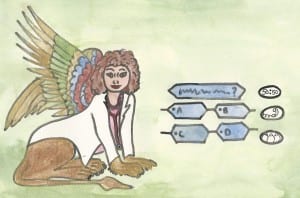
Dr Sphinx & The Riddles of Studying Medicine
The myth of the sphinx harks back to the days of ancient Egypt, where storytellers told of a beast; part man, part lion and part eagle. This fantastical amalgamation would stop travellers on roads, challenging them to a riddle, thus testing their skills of deduction.
Though the outside world believes that these beasts were mere flights of fancy, students studying Medicine know otherwise. Within the medical profession, these creatures thrive in secret, living on through the Doctor Sphinx.
How to spot a Dr Sphinx
Evolution has drastically changed the species, most notably in outward appearance. Gone are the wings and feline features (the lack of opposable thumbs making general examination problematic). These have been replaced by normal healthcare attire and job essentials – stethoscopes, bleeps and a collection of little black pens, all at different stages of chewing erosion.
Though distinctly less cool (how awesome would a doctor with wings be? As soon as we confirm they don’t transmit Chlamydia Psittaci I’m there!), this has helped them integrate, allowing effective cooperation with other flora and fauna. Despite numerous variations, one characteristic distinguishes all sphinxes (sphinxii? sphincters?) – their riddling nature.
What to expect when you meet one
Sphinxes pose riddles to those lower than them on the food chain. Occurring at any time and without provocation, riddling consists of a sequence of medical-based questions, normally around the sphinx’s specialty.
Common riddles include questions with one definitive answer:
“what is the standard medication for….”,
questions with numerous definitive answers:
“name every type of hernia ever”,
and finally extremely open-ended questions:
“what is pain?” *face-palms*…
Regardless of how you answer this final type of medical school question, you are destined to fail. If you answer too generally, they’ll want specialty-related answers. If you’re too specific, the Doctor Sphinx will respond with the most obvious statement imaginable – “no, pain is suffering”.
Why you should try to meet a Dr Sphinx
During riddling, the Doctor Sphinx is testing a medic’s underling knowledge. An encounter is beneficial to both parties, for if the medical student makes an attempt at answering, they are taught not only the correct answer, but also improve on their ability to think under pressure. Students should attempt to answer any challenge, given the minimal risks of such an action.
Riddling will cease when one of several eventualities occurs:
- The Doctor Sphinx becomes distracted by it’s duties. Though eager to riddle, the sphinx, like all doctors, knows that the patient is the priority.
- The Doctor Sphinx grows bored, moving on to find more entertaining opponents. This occurs if their opponent responds too frequently with “I don’t know”. Always attempt to answer each riddle.
- The Doctor Sphinx runs out of questions. If a student wishes for riddling to continue, they should ask a question in response. This may reinvigorate the sphinx.
Through its riddles, the Doctor Sphinx looks to help the medics under it’s non-existent wings, not just watch them squirm under pressure (see the blog Consultasaurus Rex). Though some questions can be intimidating to the unprepared, or frustrating if deliberately vague, it is important to play along – the harder the riddles, the greater the teachings wrought.
Uploaded by Eric Richardson on 11 March 2016
